CHAPTER 88
Condylomata Acuminata
(Genital Warts)
Presentation
Patients may complain of perineal itching, burning, pain, and tenderness, although they are commonly asymptomatic, especially with cervical and vaginal involvement. Distinctive fleshy warts can be found on the external genitalia or anus (Figures 88-1 and 88-2). Lesions are pedunculated or broad-based with pink to gray soft excrescences, with multiple papillae arising from a single base. They occur in clusters or individually and can become friable. In addition to the external genitalia (i.e., the penis, vulva, scrotum, perineum, and perianal skin), genital warts can occur on the uterine cervix as well as in and around the vagina, urethra, anus, and mouth.
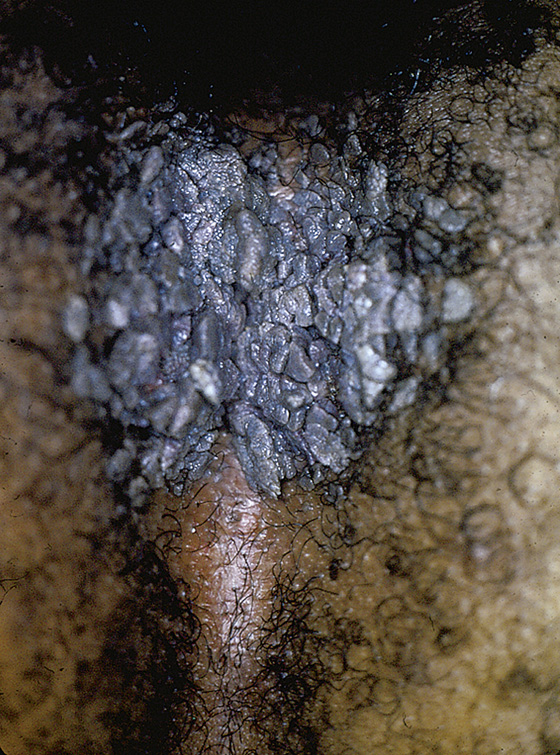
Figure 88-1 Condylomata acuminata on the perineum. (Adapted from Black M, McKay M, Braude P, et al: Obstetric and gynecologic dermatology, ed 2. St Louis, 2002, Mosby.)
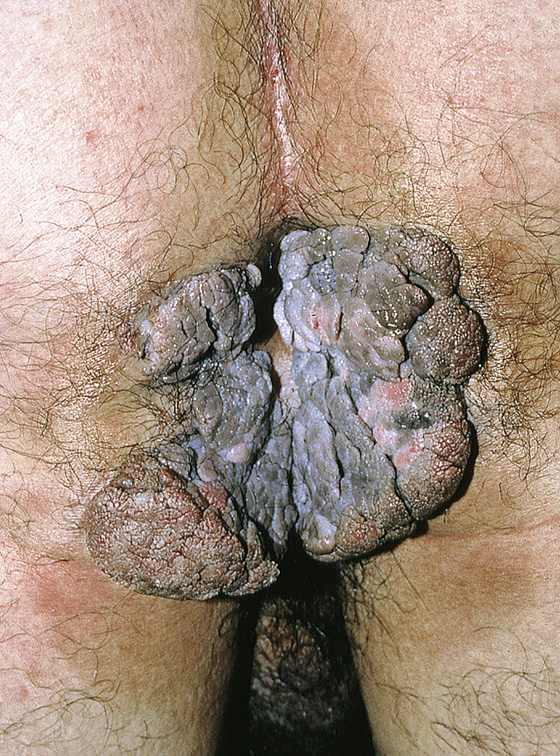
Figure 88-2 Perianal condyloma acuminatum. (Adapted from White G, Cox N: Diseases of the skin, ed 2. St Louis, 2006, Mosby.)
What To Do:
 External warts seldom require biopsy for diagnosis. Biopsy is needed only if the diagnosis is uncertain, the lesions do not respond to standard therapy, the disease worsens during therapy, the patient is immunocompromised, or warts are pigmented, indurated, fixed, and ulcerated. The differential diagnosis of anogenital warts includes molluscum contagiosum (Figures 88-3 and 88-4), verruca vulgaris (common nongenital wart), secondary syphilis (Condyloma lata, Figure 88-5), hypertrophic vulvar dystrophies, and vulvar intraepithelial and invasive neoplasias. Consider atypical, pigmented, intravaginal, cervical, and persistent warts for referral for gynecologic evaluation. Recognition of cervical lesions may require colposcopy.
External warts seldom require biopsy for diagnosis. Biopsy is needed only if the diagnosis is uncertain, the lesions do not respond to standard therapy, the disease worsens during therapy, the patient is immunocompromised, or warts are pigmented, indurated, fixed, and ulcerated. The differential diagnosis of anogenital warts includes molluscum contagiosum (Figures 88-3 and 88-4), verruca vulgaris (common nongenital wart), secondary syphilis (Condyloma lata, Figure 88-5), hypertrophic vulvar dystrophies, and vulvar intraepithelial and invasive neoplasias. Consider atypical, pigmented, intravaginal, cervical, and persistent warts for referral for gynecologic evaluation. Recognition of cervical lesions may require colposcopy.
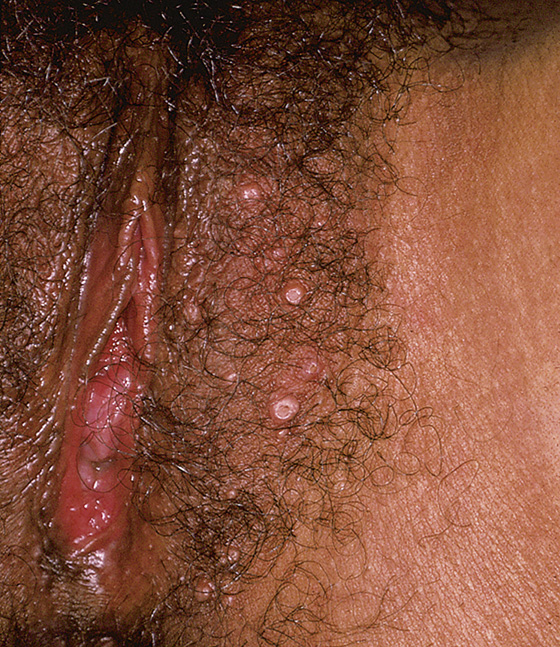
Figure 88-3 Molluscum contagiosum on the labia majora. (Adapted from Black M, McKay M, Braude P, et al: Obstetric and gynecologic dermatology, ed 2. St Louis, 2002, Mosby.)
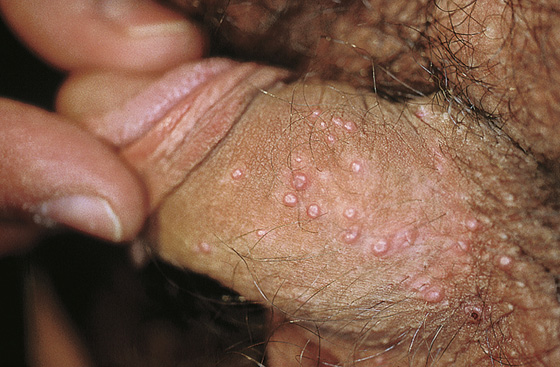
Figure 88-4 Molluscum on the shaft of the penis. (Adapted from White G, Cox N: Diseases of the skin, ed 2. St Louis, 2006, Mosby.)
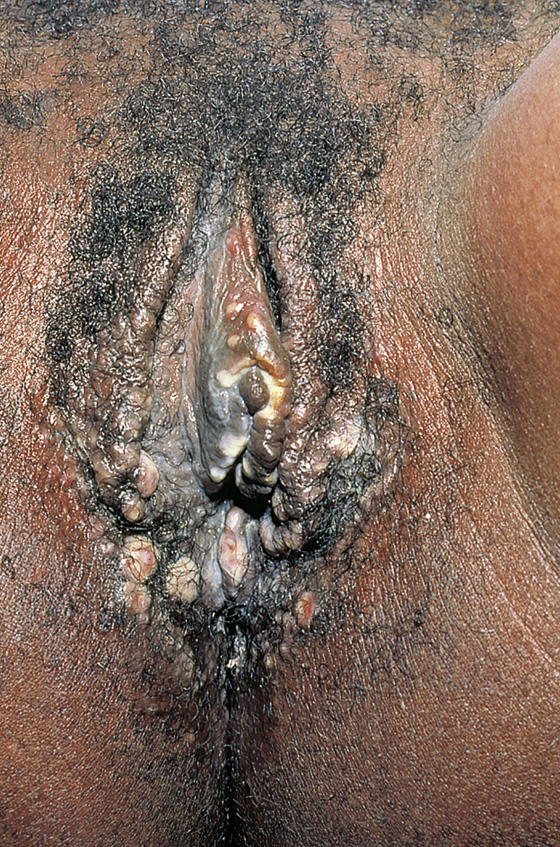
Figure 88-5 Secondary syphilis. (Adapted from White G, Cox N: Diseases of the skin, ed 2. St Louis, 2006, Mosby.)
 The primary goal of treating visible genital warts is the removal of symptomatic warts. In most patients, treatment can induce wart-free periods. Treatment of genital warts should be guided by the number, size, site, and morphology of lesions, as well as the preference of the patient, cost, convenience, available resources, and experience of the healthcare provider. No definitive evidence suggests that any of the available treatments are superior to the others. Modalities of therapy include physical or chemical destruction, immunologic therapy, or surgical excision.
The primary goal of treating visible genital warts is the removal of symptomatic warts. In most patients, treatment can induce wart-free periods. Treatment of genital warts should be guided by the number, size, site, and morphology of lesions, as well as the preference of the patient, cost, convenience, available resources, and experience of the healthcare provider. No definitive evidence suggests that any of the available treatments are superior to the others. Modalities of therapy include physical or chemical destruction, immunologic therapy, or surgical excision.
 Because of uncertainty regarding the effect of treatment on future transmission and the possibility for spontaneous resolution, an acceptable alternative for some patients is to forgo treatment and await spontaneous resolution.
Because of uncertainty regarding the effect of treatment on future transmission and the possibility for spontaneous resolution, an acceptable alternative for some patients is to forgo treatment and await spontaneous resolution.
 Most patients have 10 or less genital warts, with a total wart area of 0.5 to 1.0 cm2. These warts respond to most treatment modalities. Many patients require a course of therapy rather than a single treatment. In general, warts located on moist surfaces and/or in intertriginous areas respond better to topical treatment than do warts on drier surfaces.
Most patients have 10 or less genital warts, with a total wart area of 0.5 to 1.0 cm2. These warts respond to most treatment modalities. Many patients require a course of therapy rather than a single treatment. In general, warts located on moist surfaces and/or in intertriginous areas respond better to topical treatment than do warts on drier surfaces.
 Patients should be warned that persistent hypopigmentation or hyperpigmentation is common with ablative modalities. Rarely, treatment can result in disabling chronic pain syndromes (e.g., vulvodynia or hyperesthesia of the treatment site).
Patients should be warned that persistent hypopigmentation or hyperpigmentation is common with ablative modalities. Rarely, treatment can result in disabling chronic pain syndromes (e.g., vulvodynia or hyperesthesia of the treatment site).
Patient-Applied
 Prescribe imiquimod (Aldara) cream 5%, 12 single-use packets. Have the nonpregnant patient apply a thin layer of cream once daily to external genital and perianal warts, rubbed in until the cream is no longer visible, with hand washing before and after cream application. This should be repeated 3 times per week, prior to normal sleeping hours, and left on the skin for 6 to 10 hours before being washed off. This should continue until there is total clearing of the warts or for a maximum of 16 weeks. This cream is very expensive.
Prescribe imiquimod (Aldara) cream 5%, 12 single-use packets. Have the nonpregnant patient apply a thin layer of cream once daily to external genital and perianal warts, rubbed in until the cream is no longer visible, with hand washing before and after cream application. This should be repeated 3 times per week, prior to normal sleeping hours, and left on the skin for 6 to 10 hours before being washed off. This should continue until there is total clearing of the warts or for a maximum of 16 weeks. This cream is very expensive.
 An alternative for self-treatment is to prescribe podofilox 0.5% solution (3.5 mL) or gel 0.5% (3.5 g). Both are moderately expensive. Nonpregnant patients may apply podofilox solution with a cotton swab or podofilox gel with a finger twice daily for 3 days, followed by 4 days of no treatment. The patient should be careful to avoid the surrounding normal tissue. This cycle may be repeated as necessary for a total of four cycles. Total wart area treated should not exceed 10 cm2, and the total volume of podofilox should not exceed 0.5 mL/day. If possible, apply the initial treatment to demonstrate the proper application technique and identify which warts should be treated.
An alternative for self-treatment is to prescribe podofilox 0.5% solution (3.5 mL) or gel 0.5% (3.5 g). Both are moderately expensive. Nonpregnant patients may apply podofilox solution with a cotton swab or podofilox gel with a finger twice daily for 3 days, followed by 4 days of no treatment. The patient should be careful to avoid the surrounding normal tissue. This cycle may be repeated as necessary for a total of four cycles. Total wart area treated should not exceed 10 cm2, and the total volume of podofilox should not exceed 0.5 mL/day. If possible, apply the initial treatment to demonstrate the proper application technique and identify which warts should be treated.
Provider-Administered
 Apply 25% podophyllin in tincture of benzoin (Podocon-25). Use applicator provided. A small amount should be applied to each wart and allowed to air dry. Leave on briefly for the first treatment to assess for sensitivity, about 30 minutes or so. Thereafter the nonpregnant patient may thoroughly wash off the podophyllin in 1 to 4 hours. This may be repeated weekly if necessary, but if warts persist after six applications, the patient should be referred for alternative therapy. This is not to be used on mucosal surfaces—never to be applied on cervical or vaginal epithelium.
Apply 25% podophyllin in tincture of benzoin (Podocon-25). Use applicator provided. A small amount should be applied to each wart and allowed to air dry. Leave on briefly for the first treatment to assess for sensitivity, about 30 minutes or so. Thereafter the nonpregnant patient may thoroughly wash off the podophyllin in 1 to 4 hours. This may be repeated weekly if necessary, but if warts persist after six applications, the patient should be referred for alternative therapy. This is not to be used on mucosal surfaces—never to be applied on cervical or vaginal epithelium.
 Alternatively, apply a small amount of trichloroacetic acid (TCA) or bichloroacetic acid (BCA), 80% to 90%, only to warts and allow it to dry, at which time a white “frosting” develops. If an excess amount of acid is applied, the treated area can be powdered with baking soda to neutralize unreacted acid. This treatment can be repeated weekly, if necessary. A barrier of petroleum jelly helps protect unaffected surrounding skin, because the solution is highly caustic.
Alternatively, apply a small amount of trichloroacetic acid (TCA) or bichloroacetic acid (BCA), 80% to 90%, only to warts and allow it to dry, at which time a white “frosting” develops. If an excess amount of acid is applied, the treated area can be powdered with baking soda to neutralize unreacted acid. This treatment can be repeated weekly, if necessary. A barrier of petroleum jelly helps protect unaffected surrounding skin, because the solution is highly caustic.
 The treatment modality should be changed if a patient has not improved substantially after three provider-administered treatments or if warts have not completely cleared after six treatments.
The treatment modality should be changed if a patient has not improved substantially after three provider-administered treatments or if warts have not completely cleared after six treatments.
 Another treatment is the use of 5-fluorouracil epinephrine gel. The gel is injected intralesionally. Inject each lesion once per week for up to 6 weeks.
Another treatment is the use of 5-fluorouracil epinephrine gel. The gel is injected intralesionally. Inject each lesion once per week for up to 6 weeks.
 If the patient is pregnant, has severe involvement, or has profuse anal or rectal warts, she should be referred for cryotherapy, ablation with carbon dioxide laser, electrocautery, or surgical excision.
If the patient is pregnant, has severe involvement, or has profuse anal or rectal warts, she should be referred for cryotherapy, ablation with carbon dioxide laser, electrocautery, or surgical excision.
 If the patient’s male partner also has visible lesions (Figure 88-6), he can be treated using the same regimens. Examination of asymptomatic sex partners is not necessary, but they may benefit from counseling about their potential for future disease.
If the patient’s male partner also has visible lesions (Figure 88-6), he can be treated using the same regimens. Examination of asymptomatic sex partners is not necessary, but they may benefit from counseling about their potential for future disease.
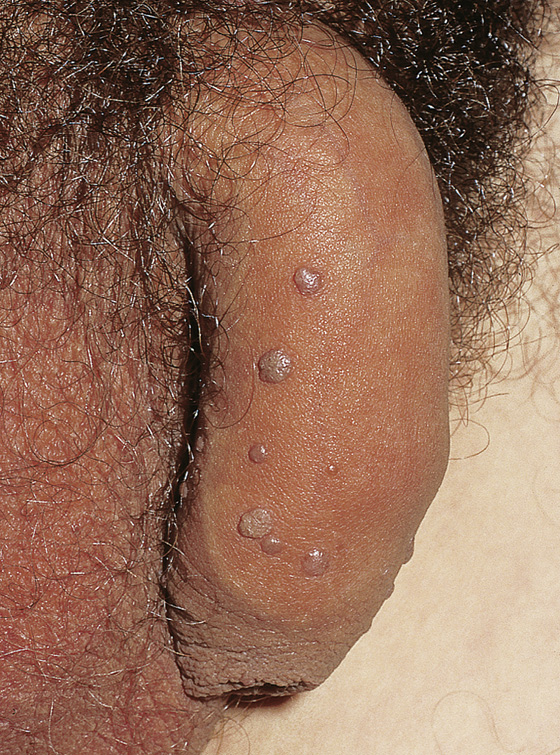
Figure 88-6 Condyloma acuminatum; multiple lesions on the shaft of the penis. (Adapted from White G, Cox N: Diseases of the skin, ed 2. St Louis, 2006, Mosby.)
 Provide patient education and counseling. Inform the patient of the following:
Provide patient education and counseling. Inform the patient of the following:
 Genital human papillomavirus infection (HPV) is a viral infection that is common among sexually active adults.
Genital human papillomavirus infection (HPV) is a viral infection that is common among sexually active adults.
 Infection is almost always sexually transmitted, but the incubation period is variable, and it is often difficult to determine the source of infection. Within ongoing relationships, sex partners usually are infected by the time of the patient’s diagnosis, although they may have no symptoms or signs of infection.
Infection is almost always sexually transmitted, but the incubation period is variable, and it is often difficult to determine the source of infection. Within ongoing relationships, sex partners usually are infected by the time of the patient’s diagnosis, although they may have no symptoms or signs of infection.
 The natural history of genital warts is generally benign; the types of HPV that usually cause external genital warts are not associated with cancer.
The natural history of genital warts is generally benign; the types of HPV that usually cause external genital warts are not associated with cancer.
 Recurrence of genital warts within the first several months after treatment is common and usually indicates recurrence rather than reinfection.
Recurrence of genital warts within the first several months after treatment is common and usually indicates recurrence rather than reinfection.
 The likelihood of transmission to future partners and the duration of infectivity after treatment are unknown. The use of latex condoms may help to prevent the likelihood of further transmission.
The likelihood of transmission to future partners and the duration of infectivity after treatment are unknown. The use of latex condoms may help to prevent the likelihood of further transmission.
 The value of disclosing a past diagnosis of genital HPV infection to future partners is unclear. Candid discussions about other sexually transmitted diseases (STDs) should be encouraged and attempted whenever possible.
The value of disclosing a past diagnosis of genital HPV infection to future partners is unclear. Candid discussions about other sexually transmitted diseases (STDs) should be encouraged and attempted whenever possible.
 After visible genital warts have cleared, a follow-up evaluation is not mandatory but may be helpful. Patients concerned about recurrences should be offered a follow-up evaluation 3 months after treatment.
After visible genital warts have cleared, a follow-up evaluation is not mandatory but may be helpful. Patients concerned about recurrences should be offered a follow-up evaluation 3 months after treatment.
 Women should be counseled to undergo regular Pap screening, as recommended for women without genital warts. The presence of genital warts is not an indication for a change in the frequency of Pap tests or for cervical colposcopy.
Women should be counseled to undergo regular Pap screening, as recommended for women without genital warts. The presence of genital warts is not an indication for a change in the frequency of Pap tests or for cervical colposcopy.
 Counsel both partners about the unpredictable natural history of the disease and the possible increased risk for lower genital tract malignancy (see Discussion). Infected women should have an annual Pap smear.
Counsel both partners about the unpredictable natural history of the disease and the possible increased risk for lower genital tract malignancy (see Discussion). Infected women should have an annual Pap smear.
What Not To Do:
 Do not use imiquimod, podofilox, or podophyllin during pregnancy. Safety during pregnancy has not been established for these agents, and there have been a few cases of toxicity reported when large amounts of podophyllin have been used.
Do not use imiquimod, podofilox, or podophyllin during pregnancy. Safety during pregnancy has not been established for these agents, and there have been a few cases of toxicity reported when large amounts of podophyllin have been used.
 Do not mistake “pearly penile papules” for warts (Figure 88-7). These dome-shaped or hairlike projections around the corona of the glans penis are normal variants in up to 10% of men.
Do not mistake “pearly penile papules” for warts (Figure 88-7). These dome-shaped or hairlike projections around the corona of the glans penis are normal variants in up to 10% of men.
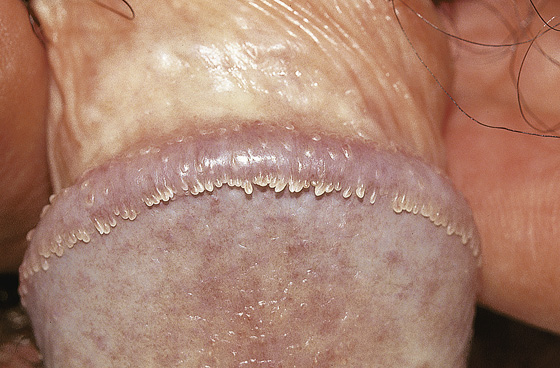
Figure 88-7 Pearly penile papules. (Adapted from White G, Cox N: Diseases of the skin, ed 2. St Louis, 2006, Mosby.)
 Do not mistake condyloma acuminatum for other lesions. Other lesions include condylomata lata, micropapillumatosis of vulva, molluscum contagiosum, and squamous cell carcinoma. If lesions are not responding to therapy, consider biopsy.
Do not mistake condyloma acuminatum for other lesions. Other lesions include condylomata lata, micropapillumatosis of vulva, molluscum contagiosum, and squamous cell carcinoma. If lesions are not responding to therapy, consider biopsy.
 Do not advise patients that clearing is a cure; recurrence is the norm.
Do not advise patients that clearing is a cure; recurrence is the norm.
Discussion
Genital warts are a result of infection with HPV. Approximately 35 types of HPV can infect the genital tract. Most HPV infections are asymptomatic, unrecognized, or subclinical. The sexual transmission of HPV is well documented, with the highest prevalence in young, sexually active adolescents and adults. HPV types 6 and 11 are the most prevalent types associated with condylomata acuminata and are not considered to have the malignant potential of types 16, 18, 31, 33, and 35. The types with malignant potential are found occasionally in visible genital warts and have been associated with external genital squamous intraepithelial neoplasia. Patients who have visible genital warts can be infected simultaneously with multiple HPV types. In addition, HPV frequently coexists with other sexually transmitted diseases. HPV lesions are difficult to eradicate, with a very high recurrence rate, and there is still no definitive therapy. No evidence indicates that either the presence of genital warts or their treatment is associated with the development of cervical cancer.
Despite current infection with genital warts, patients may still be candidates for the new HPV vaccine. They should be encouraged to seek a specialist’s advice.
Imiquimod is a topically active immune enhancer that stimulates production of interferon and other cytokines. Local inflammatory reactions are common with the use of imiquimod; these reactions are usually mild to moderate.
Podofilox, 0.5% solution or gel, an antimitotic drug that destroys warts, is relatively inexpensive, easy to use, safe, and self-applied by patients.
Most patients experience mild to moderate pain or local irritation after treatment.
Podophyllin resin, which contains several compounds, including antimitotic podophyllin lignans, must be allowed to air dry before the treated area comes into contact with clothing, or local irritation caused by spread of the compound to adjacent areas can result.
Both TCA and BCA are caustic agents that destroy warts by chemical coagulation of proteins. TCA solutions have low viscosity, comparable with that of water, and can spread rapidly if applied excessively; thus they also can damage adjacent tissues if not applied sparingly and allowed to dry before the patient sits or stands.
Surgical therapy is a treatment option that has the advantage of usually eliminating warts at a single visit. However, such therapy requires substantial clinical training, additional equipment, and a longer office visit.
Newer therapies, such as topical cidofovir and bacillus Calmette-Guérin (BCG), are under study and show promise.
The goal of present treatments is clearance of visible warts; some evidence exists that treatment reduces infectivity, but there is no evidence that treatment reduces the incidence of genital cancer. Patient-applied therapy, such as imiquimod cream or podofilox, is increasingly recommended. These treatments, used at times in conjunction with surgical excision and/or cryotherapy, are presently the most convenient and effective options.
Biopsy, viral typing, acetowhite staining, and other diagnostic measures are not routinely required.
In patients who fail to respond to therapy or who have extremely large lesions, consider evaluating for an immunosuppressed state, including human immunodeficiency virus (HIV).

Full access? Get Clinical Tree





